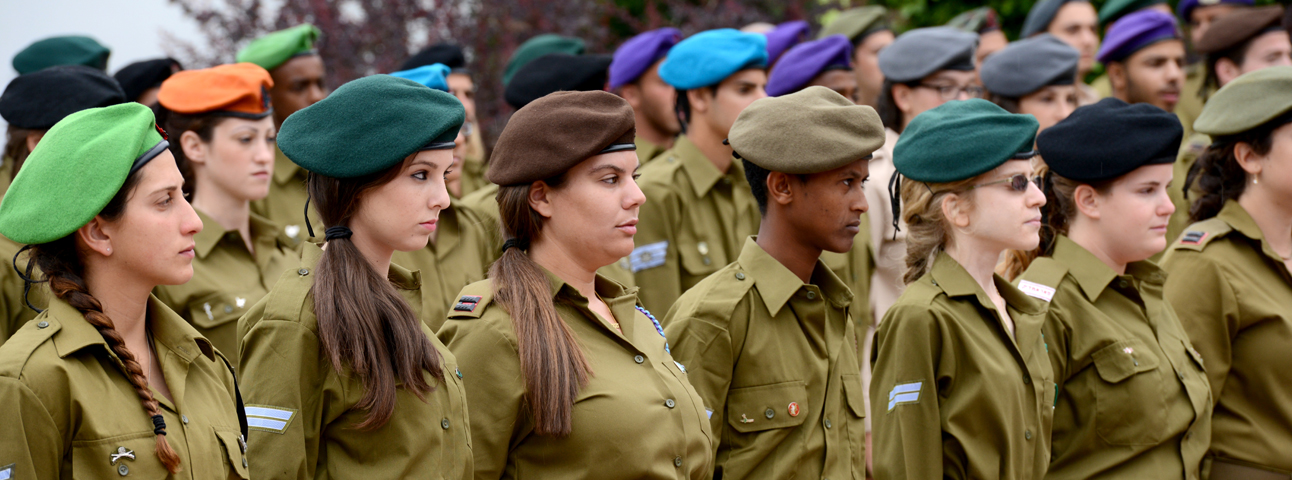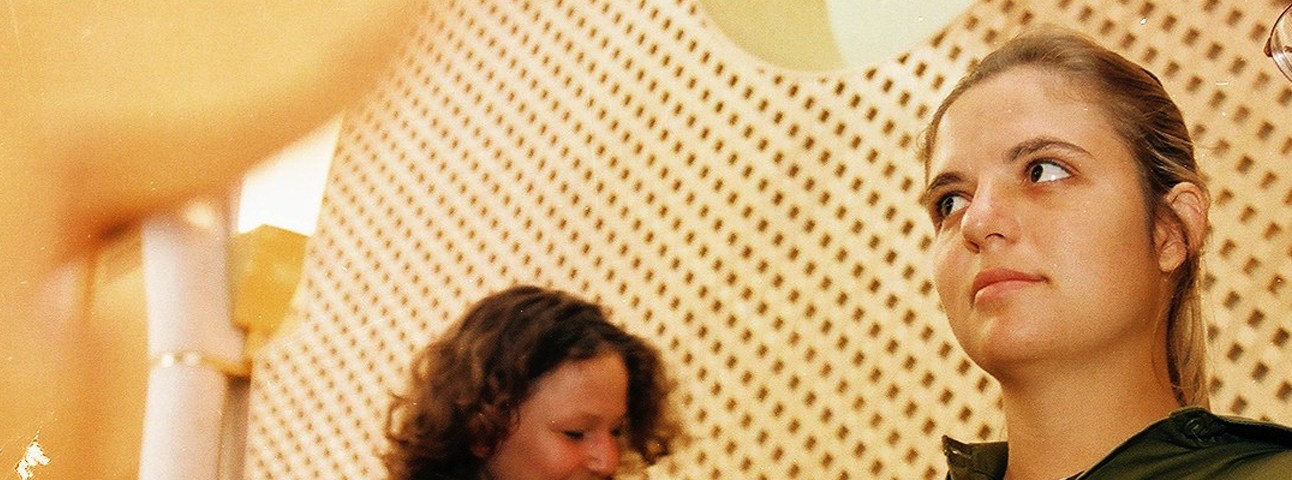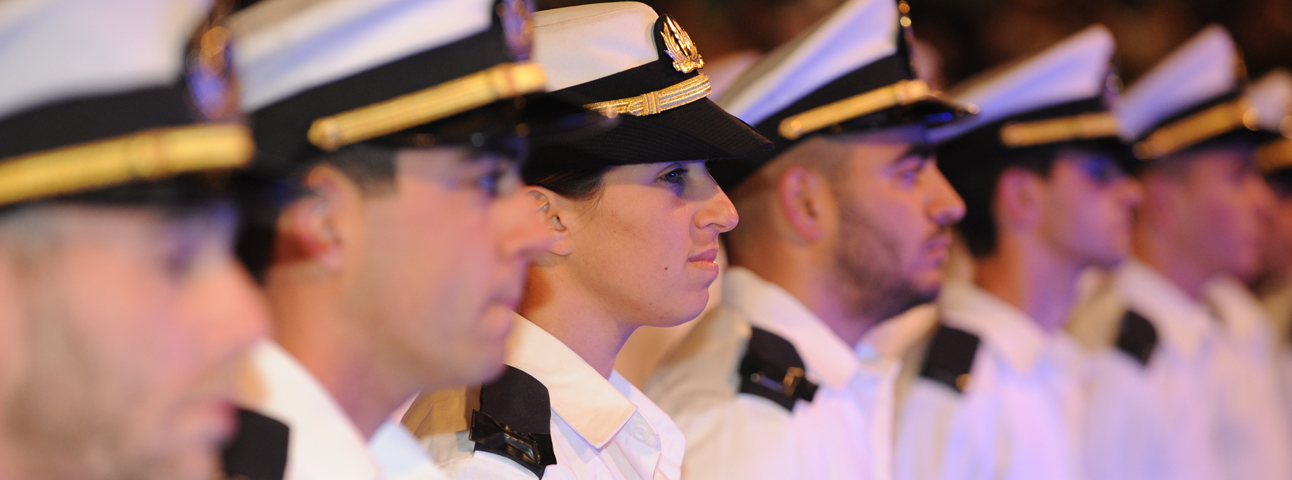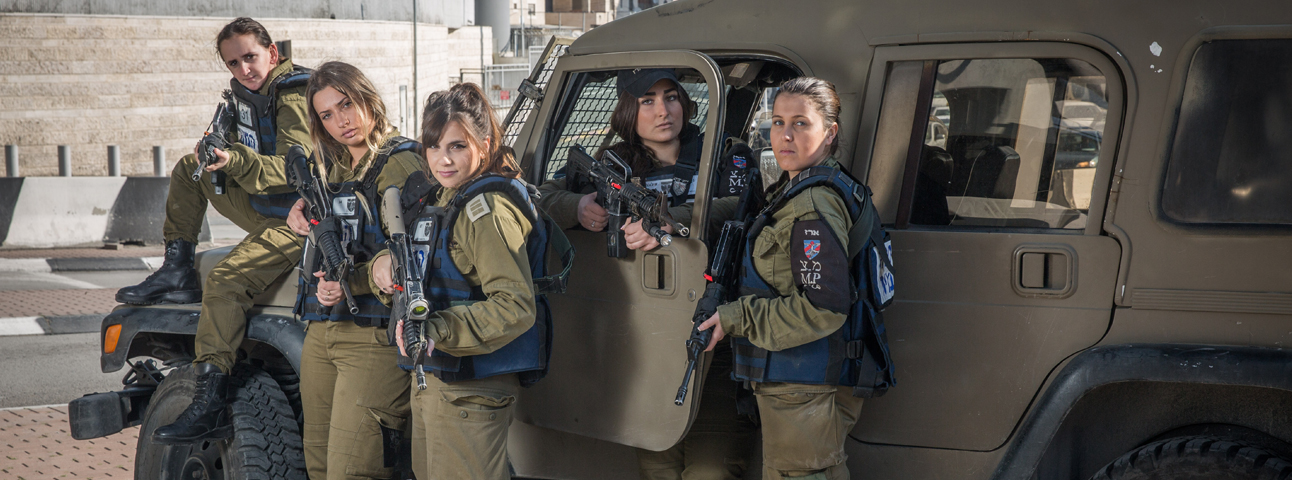Women’s Service in the IDF: Between a ‘People’s Army’ and Gender Equality
Dr. Idit Shafran Gittleman presents an overview of 74 years of women in the IDF

Illustration | Flash 90
With the establishment of the Israel Defense Forces and the dismantling of the underground militias in 1948, the government decided to draft women into the army under a law requiring mandatory service. This extraordinary measure was primarily the result of a shortage of military personnel and of Ben-Gurion’s concept of a “people’s army,” which he tried to instill at the time. Over the years and especially in recent decades, the concept of gender equality has also become relevant to the discussion of military service, and more and more roles have been opened up to women serving in the IDF. While the first two considerations depend on one’s point of view and on the army’s needs, it is clear that in the current debate on women’s military service we must give high priority to the principle of gender considerations.
The IDF is among the only armies in the world that conscripts women into its ranks under a mandatory draft law. Women served in the IDF upon its establishment in 1948, and in 1949 their service in the Women’s Corps –established by women officers who had served in the British army-- was anchored in the Defense Service Law. Israel’s first Prime Minister, David Ben-Gurion, gave two justifications for the decision to draft women to the IDF under a mandatory draft law. One was that mandatory service served the security needs of the young Jewish state, with these requiring everyone able to serve to do so. The other was the army’s commitment to the principle of social equality.
These two justifications are often seen as the underlying principles of the people’s army model according to which the IDF was established, and which continue to be a matter of almost complete consensus as to the relationship between the army and Israeli society. The view that women are drafted because the IDF is a people’s army and should therefore apply the principle of equality to all segments of society remains unchallenged, as does the approach which holds that security needs require that Israeli society’s man (and women)power potential be utilized to the fullest possible extent.
Yet despite the temptation to see the people’s army model as guaranteeing progress in promoting gender equality, this ethos does not always reflect the actual reality. As we will see, the fact that women are drafted on the basis of a mandatory draft law reflecting the people’s army model does not go very far toward guaranteeing them pro forma equality, to say nothing of equality on the ground. In this essay, I will list three factors that have impacted the integration of women in the IDF for many years, as well as on the decisions regarding opening up military units to them:
1. The perception of the IDF as a people’s army
2. Security needs
3. Social processes that contribute to, or undermine, gender equality
Women’s Conscription as an Obvious Matter
In October 1949, approximately a year and a half after the proclamation of the establishment of the State of Israel, the Institute for Applied Social Research conducted a poll asking the public whether it was in favor of equal rights for women, and indeed 92% were in favor. However, opinions were divided on the question of whether women should be drafted during peacetime (in other words, whether there should be mandatory conscription for women): 52.5% were in favor and 47.5% were opposed. Israel’s leaders, among them David Ben-Gurion, were unequivocal in this regard: Ben-Gurion believed that the state should both demand as much from women as from men, and at the same time---grant them equal rights.State of Israel, Institute for Applied l Social Research (October 1949). Public Opinion on… Drafting Women into the Army and Equalizing Women’s Rights, Publication 10 (Hebrew).
Yet despite Ben-Gurion’s firm stance regarding gender equality, at first women were allowed to serve in the army only as office workers, nurses, and teachers — positions traditionally perceived as feminine roles. It is interesting to note that despite this inherent discrimination, in the early days, the sense of mission and the motivation of soldiers in the Women’s Corps were relatively high — as demonstrated for example, by the poll conducted in September 1948 in the Women’s Corps Battalion 205, whose findings indicated that 93% of women soldiers reported being proud to belong to the Women’s Corps.
Expanding Women’s Army Service
The view according to which women belonged on the home front, and men-- on the front lines also prevailed after the 1973 Yom Kippur War, a time of pronounced gender inequality, despite the fact that a woman was serving as prime minister at the time. During this time, women were excluded from playing a part in the three primary tasks of warfare: military defense, civil administration, and military production.Einat Lachover, “Women in the Six Days War through the eyes of the media.” Israel 13 (2008): 38. After the war, due to the need to build up its troops, the army adopted a new and expanded policy regarding women’s placement in military roles, enabling women to be trained for roles that, until that time, had been open only to men. The opening up of these new roles was based on the view that drafting women should free up men from positions on the home front, enabling them to participate in combat, and so--most of the training effort was directed toward positions such as instructors, drivers, aircraft mechanics, and communication jobs.
Nevertheless, we can identify far-reaching measures that were taken during those years regarding women’s military service, such as lifting the restrictions that had existed until then on women’s presence in combat areas, particularly over the border (1982), and removing the section of the Defense Service Law that listed the positions and roles closed to women (1987).On the relationship between this statistic and the issue of women taken prisoners, see Brig. Gen. Rachel Tevet-Wiesel and Lt. Col. Ariel Weiner, “Forward in spite of everything,” Ma’archot 456 (August 2014): 39 (Hebrew).
To sum up, from the day the IDF was established until the 1990s, commitment to women’s equality was expressed mainly in the mandatory draft for women and the anchoring of their conscription in law. But as for integrating them into units and the scope of positions open to them, the needs of the hour along with gender stereotypes regarding “feminine” roles, dictated the reality on the ground.

Illustration | Flash 90
The Turning Point: The Alice Miller Case
For the most part, the IDF’s approach to women’s service can be divided up into two periods of time: the first---before the Alice Miller case (1995) — or more precisely, before the Defense Service Law was amended in 2000 following the High Court of Justice’s ruling on the case — and afterward. The significant difference between these two periods does not lie in the number of units that were opened up to women — a process that was accelerated once the ruling was issued — nor in the percentage of women who enlisted, which actually decreased. Rather, what changed was the motivation for integrating women into army units and the principle underlying the integration of women into the IDF and utilizing their potential to the maximum.
As noted, Alice Miller submitted her petition to the High Court of Justice when the army rejected her as a candidate for the pilots’ course because of her gender. The High Court of Justice ruled that women had the right to equality in their military service—both formally and on the ground, and that the army’s policy of barring them from service as pilots was unacceptable. Not surprisingly, this ruling had a profound effect on the various units that the IDF ordered opened to women, including those that until then had been an exclusively male monopoly. But the turning point created by the ruling was not just a matter of procedure. For all practical purposes, the court’s ruling ordered the IDF to integrate women into its ranks not only as a function of defense and security needs, but also based on the commitment to the principle of equality. This historic ruling sought to make it clear to the state that the principle of equality was not being upheld as long as the phrase "defense requirements” was cited; the principle of equality must, for the most part, take precedence. As Justice Tova Strasberg-Cohen wrote: “In the conflict between the value of equality and the value of national security and military needs, national security may be regarded as of higher-priority, notwithstanding the importance of equality. But national security is not a magic word; it does not take precedence in every case and under all circumstances, nor is it of equal weight for all levels of security and for every security threat.”HCJ 4541/94 Miller vs. Minister of Defense, 49(4) P.D. 94 (1995).
From the Ruling on the Miller Case to the Present Day
On January 1, 2000, following the High Court of Justice’s ruling on Alice Miller’s petition, the Defense Service Law was amended to state that every woman, just as every man, had the right to serve in any position in the army unless the inherent nature of the position required otherwise. The first new position to be opened to women was that of air force pilot. This was followed, gradually, by fourteen other positions such as naval officer, combat soldier in the Border Police, anti-aircraft combat soldier, soldier in the Caracal combat unit, and combat soldiers in the Combat Rescue, Evacuation and Airborne Medicine Unit.
Combat Positions Opened to Women, by Year:

Illustration | Flash 90
| Year | Position |
| 1995 | Pilots |
| 1996 | Combat soldiers in the Border Police |
| 1997 | Combat soldiers in anti-aircraft units; naval officers |
| 2000 | Combat soldiers in the Caracal unit (the first mixed-gender combat unit); combat soldiers in the Combat Rescue, Evacuation and Airborne Medicine Unit; combat soldiers in the Artillery Corps |
| 2001 | Parachuting instructors |
| 2003 | Combat soldiers in the Oketz (canine) unit; battalion communications officers |
| 2006 | Combat soldiers in the field intelligence collection unit |
| 2015 | Combat soldiers in the Lions of the Jordan Valley unit |
| 2017 | Combat soldiers in the Lion of the Valley unit (the fourth mixed-gender battalion) |
| November 2018 | The first five women were recruited to combat navy positions on “Yasur 6” missile ships. A sixth female soldier will join the other women at the end of basic training. |
| 2019 | A woman was appointed to the position of Commanding Intelligence Officer (Central Command) |
| 2019 | A woman was appointed Battalion Commander in a regular regiment (Northern Bashan Regiment) |
| May 2020 | 1st female Battalion Commander in artillery corps |
The first mixed-gender infantry unit, Caracal, was established in 2004. Since then, the percentage of military roles open to women has increased steadily. In the 1980s, 55% of the positions in the IDF were open to women; in 1995—73%; and in 2005—88%, and since 2012, 86% of the IDF’s units have been open to women.Neta Moshe, “Women’s Military Service in the IDF.” Submitted to the Knesset Committee for the Advancement of the Status of Women. Jerusalem: Knesset Research and Information Center, May 2013 (Hebrew). See also: Meytal Eran-Jona and Carmit Padan, “Women’s Combat Service in the IDF: The Stalled Revolution,” Strategic Assessment 20 (4) 2018: 92. In addition, according to IDF statistics, the number of women combat soldiers in the infantry increased by 350% between 2013--2017, and the total number of women combat soldiers has increased sevenfold since 2005, as per the graph below.IDF Spokesperson’s Unit.
As of February 2022, approximately 18% of the combat force are women. Concomitant with the increase in the percentage of women serving as combat soldiers, IDF officials report a decline in the percentage of women serving in clerical positions (Graph 2).From: A Special Survey: Women’s Service in the IDF. IDF Spokesperson’s Office, July 2009.
Alongside the expansion of roles open to women, the IDF has taken measures to change its overall approach to women’s military service. As a reflection of this change, the Women’s Corps was dismantled in 2001, and the position of Advisor to the Chief of Staff on Women’s Affairs was established in its place (its name was later changed to the Advisor on Gender Affairs). The position was established to reflect the view that there should be no specific gender-based treatment of women’s affairs; rather, that women soldiers—just as their male counterparts—should be subordinate to their commanding officers in every way, except when it came to dealing with characteristics unique to women. The unit’s role includes promoting equal opportunities for women in the IDF.A survey published by the IDF Spokesperson’s Office stated, in part: “Unlike the Women’s Corps, which to a large extent fixed the role of women in the army, the role of the chief of staff’s advisor on women’s affairs is to promote the conditions for equal opportunity, using the talents and abilities of women in the army to the fullest, and providing women serving in the army with an environment that is safe and free of discrimination” (A Special Survey: Women’s Service in the IDF. IDF Spokesperson’s Office, July 2009). Army officials saw this act as a significant milestone in shaping the approach to women’s integration in the army.
The committee charged with defining women’s service in the IDF over the next decade, headed by Maj. Gen. (res.) Yehuda Segev, published its report in September 2007. The committee established the principle of “the right person in the right place”, according to which “the abilities of men and women will be utilized to the fullest extent possible in service in an identical manner, according to objective criteria reflecting the army’s needs, and the energy, abilities, and personal traits of the conscripts, and not their gender.” The committee also stated: “No positions or units shall be categorically closed to women or to men.”From the Segev Committee Report.
Even though most of the Segev Committee’s recommendations were never adopted — due, among other things, to pressure from religious officials who opposed them — since the ruing on the Alice Miller case, commitment to gender equality has been the main motivation underlying the integration of women in the IDF. This holds true despite the fact that all agree that the decision to open up more units to women also stemmed from the army’s need for highly motivated recruits. Evidence of this may be found in the statement of Chief of Staff Gabi Ashkenazi in 2009, when he mandated that the IDF, as a people’s army, give high priority to striving for and implementing gender equality.
In his statement, Chief of Staff Ashkenazi listed three motives for integrating women on an equal footing as men into the IDF: 1) Women must serve in the army because the IDF is a people’s army; 2) As a people’s army, the IDF is committed to the principle to the integration of women; 3) Women are integrated into the IDF as part of operational requirements that are vital for keeping the army strong and professional. Yet despite the obvious trend toward opening up the army to women, this equality is being challenged from new directions.
In August 2020 the Strick Committee, headed by Ground Forces Head Maj.-Gen. Yoel Strick is established to examine permitting women enlistment into all combat units. The preliminary recommendations have been submitted and the IDF is due to publish its conclusions by May 2022.
Defense Needs and the People’s Army: A Twist in the Plot?
In parallel to the opening up of more and more units to women following the High Court of Justice’s ruling on Alice Miller’s petition, the percentage of national-religious men in the officers’ ranks of combat units has increased, as has the percentage of ultra-Orthodox conscripts.See, for example, Yaniv Magal: Srugim Bakane: The Story of Religious Zionists’ Integration into the Army. Tel Aviv: Yedioth Ahronoth, 2016 (Hebrew). It became clear that conflict between the gender revolution in the IDF and the demands of religious male soldiers is unavoidable. For this reason, IDF officials ordered the development of regulations for joint service, with the intention being that these regulations would be anchored as standing orders. At first, in 2002, this order, which was known as the Proper Integration Ordinance, set the rules for separate living quarters and modesty restrictions, while also stipulating the rights of the religious soldiers, such as refraining from certain activities requiring being with women in close quarters. With the increase over time in the number of women’s’ complaints that this order was being interpreted in an offensive manner and was leading to discrimination against and exclusion of women soldiers, the order was suspended. After many versions, and while it still aroused a public uproar of rare magnitude, the order was updated and its final version issued in December 2017 as the Joint Service Ordinance. Its opening statement reads, in part, as follows:
“The purpose of the joint service policy is to meet the operational goal of the IDF and maintain unity in the military environment. It is based upon the fact that the IDF is the army of a Jewish and democratic state — and on the view of the IDF as a people’s army [emphasis mine], according to which soldiers of all types, religions, and ethnic groups serve in the IDF. The policy was established based on an official, egalitarian, and tolerant view, which is anchored in the values of human dignity and the spirit of the IDF.”
The profound debate on the ordinance, which evolved into a fight between the religious Zionist community and women’s rights organizations, was conducted simultaneously along two tracks: a formal track with IDF officials, and a second track that took the form of a large-scale, bitter public campaign. The uproar about the ordinance and the way that it was handled in the army is fascinating, and raises many questions and issues. Of particular interest is the fact that the campaign, led primarily by the national-religious sector, cited both factors — the model of the people’s army and defense needs, which had been the primary motivations for integrating women into the IDF when the state was established — as fundamental reasons to oppose the integration of women into various units. Time and again, the religious officials justified their opposition to the integration of women into operational units by stating that such integration, influenced as it was by radical feminist agendas, violated the principle of a people’s army and jeopardized the operational capabilities of the IDF and the defense of the state.
For example, one of the pamphlets distributed as part of this campaign stated: “The army is not a tool for promoting agendas, but rather –a people’s army.” Another booklet listed the values violated by the trend toward “joint service”.
Although IDF officials report that the Joint Service Ordinance has been updated for the last time, the uproar it caused has not subsided. Alongside clarifications about the IDF’s commitment to equality and its recognition of women’s role in the army’s functioning (as Chief of Staff Gadi Eizenkot said, “A cutback in women’s service will be detrimental to the IDF and its performance”)https://www.israelhayom.co.il/article/514113 (accessed August 26, 2018)., army commanders have recently been making statements that seem to be dragging the IDF backward.
As far as views on women’s service, the two arguments that seem to underlie the integration of women in the IDF over the years—are the people’s army model and defense needs — with the emphasis on one or the other depending on personal points of view. They can be used at will as reasons to support egalitarian integration, or to oppose it. But the commitment to actual gender equality is the only commitment that keeps the idea of women’s integration in the IDF from backsliding — and it was this very commitment that the High Court of Justice cited in its historic ruling, informing the state that it also applied to the army and was not to be left at the gates of the induction center.

Illustration | Flash 90
Milestones in Women’s Service in the IDF
1949 — The Defense Service Law, making army service compulsory for women, is passed. At the time this law was passed, the duration of military service was 30 months for men and 18 months for women. According to the law, women could ask to be released from the army on grounds of religion or conscience
1952 — Amendments made to the Defense Service Law listed positions open to women — 25 in all. The amendments also stated that women could volunteer for additional positions
1987 — The three permanent restrictions on women’s army service enumerated in the Defense Service Law, barring women from serving in combat roles, in positions in which conditions were not appropriate for women, and in positions that required physical strength, were abolished
1995 — Alice Miller’s petition is submitted to the High Court of Justice. The court rules that women have the right to equal opportunity, both formally and in practice, in their military service, and that the army’s policy of barring women from serving as pilots is invalid
1998 — Sheri Rahat, a combat navigator, becomes the first woman to graduate from the pilots’ course
2000 — An amendment is adopted in the Defense Service Law stipulating that every woman has the right, equal to that of men, to serve in any position during her army service unless the inherent nature of the position demand otherwise
2000 — Ora Peled becomes the first woman graduate of the naval officers’ course
2001 — The Women’s Corps is dissolved
2004 — The first Caracal Battalion is established
2007 — The Segev Committee report is published. The report establishes, among other things, that placement should be based on the principle of “the right person in the right place,” and states that no positions or departments shall be closed categorically to either women or men
2011 — The first woman is promoted to the rank of Major-General: Orna Barbivai, head of the Manpower Directorate
2014 — Or Ben Yehuda is appointed the first woman company commander in an infantry officers’ course
2016 — The title “Chief of Staff’s Advisor on Women’s Affairs” is changed to “Chief of Staff’s Advisor on Gender Affairs”
2017 — The Joint Service Ordinance is updated
2018 — A woman is appointed commander of a flight squadron for the first time
August 2020 — the Strick Committee, headed by Ground Forces Head Maj.-Gen. Yoel Strick is established to examine permitting women enlistment into all combat units
November 2020 — The Supreme Court decided to allow four women to submit a petition for the IDF to allow female conscripts to serve in elite combat units. The Justices also asserted that the IDF must complete the work of the existing committee that is examining the integration of women into combat units.
July 2021 — Second woman is promoted to rank of Major-General and for the first time a woman is appointed as Military Advocate
November 2021 — A woman is appointed for the first time as squadron commander in the Air Force's Flight Academy
December 2021 — A woman ranking Brigadier General is appointed Military Secretary for the President
February 2022 — A third woman is promoted to the rank of Major-General, and is appointed to President of the Military Court
